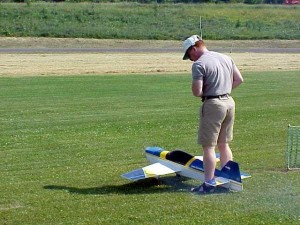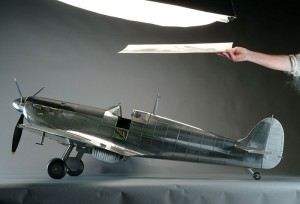
This debate started with an email from my friend Frank (below). To paraphrase it: Model airplane enthusiasts have moved to prefabricated planes and people no longer build them. He argues it’s now a toy industry and the model airplane industry is gone. This sentiment is popular among model airplane enthusiasts today. Is my paraphrase right?
I disagree with the view (below his email) .
I’ll try to make this readable.
I have been going to the Perry GA R/C Swap Meet for a number of years now. This year I saw the writing on the wall. I observed a very large number of people purchase ARF and RTF package planes. [ARF stands for Almost Ready to Fly and RTF stands for Ready To Fly.]
Few kits were offered by any vendors, and most kits were older kits from someone’s “stash”. I saw only three rolls of Monokote for sale. That was it, only three. Used glow engines cheap were everywhere. 72 Mhz radios were almost being given away. Receivers, some new, name brands for five and ten dollars.
I fear that in ten to twenty years, there will be no more hobbyists that can build a modelairplane. Oh, yes, the free flight and rubber modelers will still be there, but the numbers of them as compared to the “buy and fly” people will be totally outweighed by those who seek instant gratification.
There will be few, if any, kits offered for a modeler to build …and few, if any, new kits offered. I always felt that half the pleasure…and pride…of model aviation was being able to build from a kit, or from a set of plans, and then bring that creation out to the flying field and fly it. An accomplishment, a thing of pride, indeed. I, personally, get much more satisfaction from flying a plane I have built myself, than an ARF, that I had bought. There is no pride in it.
The numbers of people who build enormous planes and jets are increasing and the prices and values of these planes are increasing as well. Discouraging for a young fellow who wishes to learn to build and fly a model airplane. Some of these cost more than an automobile. There are some people who are fantastic flyers who cannot stick two pieces of balsa wood together. Great for them, but bad for the future of modeling itself. One can only agree it is progress, but in what direction?
As an example, I see many young people, and people in their forties as well, who have not a clue as to how to hold a pen or pencil, as the written word is becoming extinct in favor of the keyboard. The schools no longer teach a child how to write with a pen or pencil. Just grab it and go.
There is no stopping progress. It is inevitable, but one can only lament the demise of themodel airplane kit and the unique satisfaction of being able to build it, and then fly it yourself..
Anything that comes easy is lightly regarded. If one works to acheive something, it is a source of pride, and often, admiration of others. “No, I didn’t buy it, I built it myself !”
There are modelers… and there are fliers. The modelers made the industry, the fliers who do not, or will not build, in the end, will destroy the hobby industry as we have known it. Progress?
Just my personal opinion, you know. —Frank Schwartz. 86 years young, building and flying for 76 years
My response:

I agree the hobby has become “toyified” to a great extent. You just buy prefab stuff and get busy. If we went back to the past and told people about what was coming they would not believe us. For instance this Christmas I bought my 45 year old brother a radio controlled helicopter for 50 dollars. He is not a model plane enthusiast and flew very successfully around the living room. Just a few years ago to fly a helicopter in your living room, you’d have to be some sort of high priest of aviation and have a deep wallet. But now it’s a toy. A toy with stabilization systems, on board computers, advanced battery systems and extreme composite materials.
Is making model airplanes become an item of nostalgia? At face value it appears that way. This is the reason I did the Squirrel Model Airplane project. To increase the accessibility of the hobby and add something in at the very low end to try and hook more people onto the joy of building and flying a simple model airplane.
After a lot of thinking about this (and a lot of doing), I’ve realized if we zoom up to a higher vantage point we can see that it’s not bad what”s happened. In fact we’ve seen this sort of thing before.
Consider this. I know of the days of building your own radio. That was replaced by prefab systems and thought to be a loss to the hobby by many electronics enthusiasts. But people just spent the time working on building the planes and getting into flying. We moved from the galloping ghosts to proportional system which enabled pattern and aerobatics. Focus moved away from the radio to the airframe and power systems. The prefab radio added a different flavor of richness to the hobby. Less electronics and more flying. These radios added other conveniences like control mixing, flapperons and other oogabooga. It was a whole new world of fiddling. Computerized radios let you share a radio across different aircraft and save the preferences (trim and so forth). We were doing perfect rolling circles instead of maintaining engines and electronics.
So I argue that loss of the making of the radio wasn’t all bad.
The new turn key ARF/RTF is disturbing but making is not dead. There is a movement towards making things. It’s just that the traditional model plane community is isolated from this movement. We’ve been an olkSku club. Associations and clubs have tried to keep things the same and “protect” the traditions. That’s because there is a bit of resistance among many of the current practitioners to some of the new technologies. We’ve not kept up.
The proof.
Innovation in the model airplane space is alive and well. Everything is back on the table ranging from materials, control systems, closed circuit cameras, automation and you name it.
Here is some support to my claim:
1) TED.com. Evidence of the maker movement is there. Also model aviation innovations. Here’s some work on materials with this ornithopter project. Some work on autonomy. Also there are new origami (and other) known as walk-along gliders (jump ahead to 18m on this video). For more on autonomy go to the walk-along video position 17m. TED is an amazing venue. I recommend watching a video everyday to be inspired and keep up with what’s happening in the world.
2) Makezine.com. This is a whole magazine dedicated to making things. Model planes aren’t strongly represented (not very many of us have been outside of our clubs to contribute here). Squirrel Model Airplane was covered in their magazine unbeknownst to the general model airplane community. Someone did a folding wing glider which I linked to during my regular reasearch. Go ahead and sign up for daily updates. You’ll be amazed how much is going on. They just send one update per day so don’t panic. 🙂
3) Instructables. More on the maker movement. You can see hoards of DIY projects there. Here’s a walk-along-glider.
4) MakerFaires. These are conventions of makers, artists, thinkers and other cool people. Squirrel model plane has been to four of them. Two in New York City, one in Toronto and one in Ottawa. I urge you to check out if there is a makerfaire near you (or even a mini makerfaire). I promise you attending one of those will amaze you.
5) The Economist did a write-up about the maker movement in the Jan 2012 issue. I have it if anybody wants to see those pages. They talked about some of the innovations in DIY electronics and microcontrollers such as Arduino.
The Punchline.
In the beginning, model plane enthusiasts made everything. The engine, the plane, the radio and took pride in that.
Eventually engines became prefab so people focused more on the rest.
Radio controlled systems went kit then prefab. So the focus moved ahead.
Airframes became ARF. So the focus moved ahead.
RTF came and is embraced by many. But with the time savings of all this new fab technology, many didn’t move ahead.
Some people left the community or didn’t join and moved on too:
Autonomy, miniaturization, telemetry, communication, materials, collaboration and much more.
We’ve simply not had enough presence in the new venues so we don’t know what’s going on.
There are still makers and designers. Our community has just been out of the loop.
